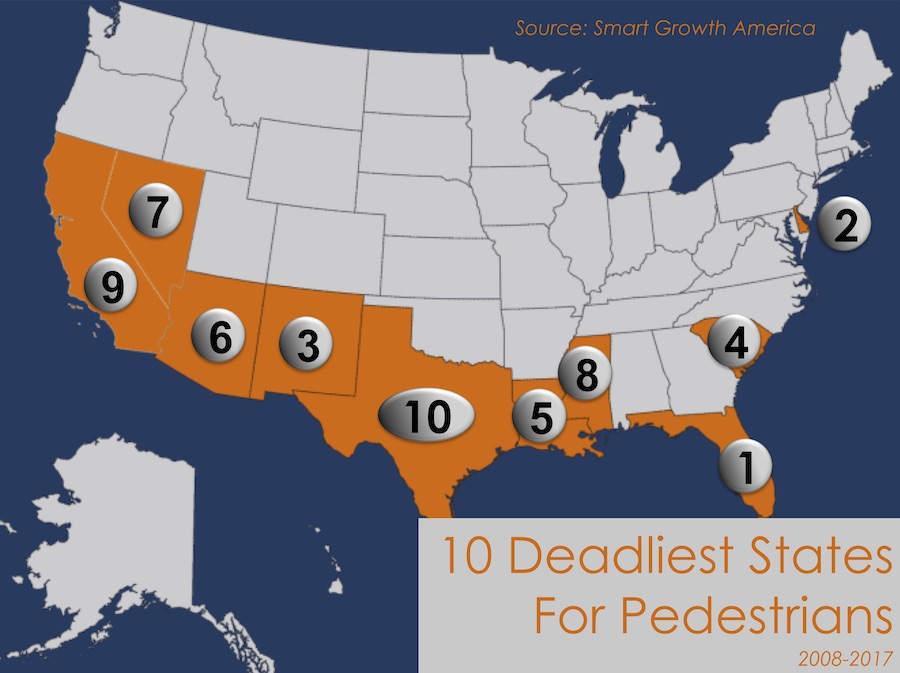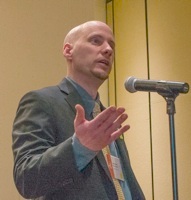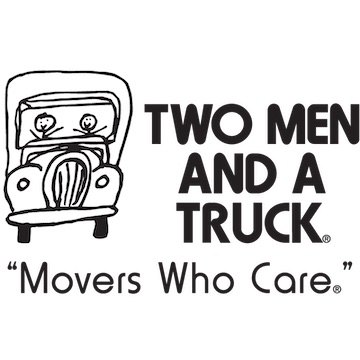Why Delaware Kills So Many Pedestrians Every Year and What We Can Do About It

Nine out of the 10 most deadly states for (2008-2017) pedestrians in America stretch, in a continuous and uninterrupted band, across the southern U.S. from Arizona to Florida. And then there’s Delaware. (Data: Smart Growth America)
Every single year in Delaware between two to three dozen people are struck and killed by motor vehicles while walking. Between 2008 and 2017, that made Delaware the second deadliest state in America (pedestrian fatalities per capita) for pedestrians (behind only Florida ). We can do something about all this unnecessary death and grief, and the shattered families it leaves in its wake, but only if we first understand why it’s happening.
Imagine that three dozen people were being killed every year in Delaware in terrorist attacks. It’s fair to imagine that what to do about this would be a prominent topic of public conversation among politicians and other government officials. Why doesn’t what to do about preventing more dead pedestrians spark a similar amount of outrage and focus? In the imaginary example of terrorists, nobody would really be arguing about the cause of the problem (the terrorists) and we could all move ahead to debate ideas for countermeasures based on that shared understanding. But when it comes to what to do about pedestrian fatalities, there has been a notable lack of consensus about causes which has, historically, paralyzed government action.
Perhaps the most important example of the confusion that has gripped the debate (such as it is) about pedestrian fatalities is whether to blame pedestrians or drivers. You can see this debate play out online after fatal crashes as drivers (I assume they are drivers) indulge in passionate diatribes about the supposed intelligence of the pedestrians who have just been killed. (For some choice examples of these sorts of comments, I highly recommend reading this.) Meanwhile, there is an almost exact mirror of these comments among many pedestrian advocates who seem equally passionate and sure that the problem is distracted or texting or reckless or drunk drivers.
THE REAL PROBLEM
All of this is distracting nonsense but the only way to understand that it’s nonsense is to actually look at the data. And when you do that – when you really do a deep dive into the facts of pedestrian fatalities in Delaware – an incredibly strong pattern emerges. What you find is that the problem of dead pedestrians is mostly not in Kent County or Sussex County. It’s mostly not a problem of Wilmington or Dover. Nor is Newark, with its 10s of thousands of UD students crowding its streets at all hours of the day and night (and not always completely sober either) the main locus of Delaware’s problem. Instead, in Delaware, pedestrians are mostly being killed in suburban New Castle County. But not just “suburban New Castle County” in general. Rather, pedestrians are mostly being killed on a relatively small number of high-speed, multi-lane suburban New Castle County arterial “corridors” such as Kirkwood Highway, Dupont Highway, Pulaski Highway and Concord Pike.
There is literally zero evidence that Delaware has either a uniquely moronic class of pedestrians or reckless class of drivers. But there is overwhelming evidence that Delaware’s pedestrian fatalities are a direct result of the deadly conditions we have created on our “commercial” highways where two different and independent levels of government have been working at cross-purposes for decades to create this perfect storm of death and grief. On the one hand, State government (the Delaware Department of Transportation) has designed these highways (and posted speed limits along them) for cars and trucks to travel nearly as fast as on our limited access highways (I-95 and Route 1). On the other hand, County government has decided that it wants these highways to be platforms for commerce and development and has zoned the land alongside them for strip malls, offices and hotels, which have created origins and destinations that generate pedestrian trips across these highways (especially the most deadly type of trip at mid-block, “uncontrolled” locations).
Trying to optimize these highways for both mobility (as roads) and access (as streets), however, we end up instead with something that is less than (much, much less than) the sum of its parts. With regard to economic development, these corridors generate a relatively low level of economic activity due to a combination of the low density of the development combined with the economic sterility of the vast amounts of acreage given over to parking lots. With regard to mobility, these commercial highways are far more dangerous than our limited access freeways, to motorists as well as pedestrians. Kirkwood Highway, Dupont Highway and other similar corridors end up being neither good roads nor good streets. Instead, they are a malfunctioning hybrid of the two: a “stroad.”
WHAT WE ARE DOING ABOUT DELAWARE’S DEADLIEST SUBURBAN HIGHWAYS
With a clear understanding of the problem, we are now in a position for the first time to actually implement solutions. These solutions come in two categories depending on what our vision for a given corridor is. In an urban context, commercial highways should evolve towards becoming more street-like. They should be redesigned to be slower and and with fewer lanes (known as “traffic calming“). But as I mentioned above, the vast majority of Delaware’s pedestrian fatalities actually are not occurring in our cities. Instead, they are out in the suburbs on our regional highways where we have almost no examples of traffic calming anywhere in the U.S. that have been implemented in situations with volumes of traffic that are so high. So our vision for these corridors has to acknowledge that they are roads. With that acknowledgement, here are the six solutions that Bike Delaware is working on:
- Bus Stops. Most of the pedestrian fatalities on our commercial highways are the result of what are known as “mid-block” crossings. Bike Delaware has worked with DART to update its bus stop location policy so that locating bus stops at mid-block locations on major highways is no longer permitted. In addition, we have worked with DelDOT to develop Delaware’s first capital project to relocate existing mid-block bus stops to intersections with signalized crosswalks. (This actually has a nice side benefit of also speeding up transit service for riders.)
- Continuous and Well-Maintained Sidewalks. This is absolutely basic. When a pedestrian is at a mid-block location on one of our deadliest suburban highways, we need to do everything we can to make it as easy as possible for her to access safe (i.e. signalized) crosswalks. Bike Delaware has been working for several years with DelDOT to get major sidewalk projects off the ground. The first one, extending 7 miles (!) on each side of Dupont Highway, is currently in design.
- More Crosswalks. Where we can, create more engineered (i.e. signalized) crosswalks to make it more likely that pedestrians will choose to cross at a safe place.
- Median Barriers. Our strong preference is for transportation solutions that increase both safety AND mobility. The problem of pedestrian mid-block crossings on Delaware’s commercial highways, however, has become so deadly and severe that it has become a unique case where we are, reluctantly but firmly, supporting a solution that restricts pedestrian mobility. We are supporting median barriers as a countermeasure against mid-block crossings on suburban highways (and only these highways) because the evidence for their effectiveness is unambiguous.
- The Data We Desperately Need About Pedestrian Origins and Destinations. Bike Delaware successfully worked in 2016 and 2017 with the Delaware State Police to update the online form that the police use whenever there is a serious pedestrian crash so that we can find out where pedestrians involved in serious crashes were going to do and coming from. This data – which we have never had before – will become increasingly important going forward to enable us to make good, data-driven decisions about improvements and changes on our deadliest highways in the future.
- Careful Planning – and Safety-Oriented Regulation – Regarding Development Along Major Highways that Prevents Development that Directly Causes More Pedestrian Mid-Block Crossings. It is possible to develop along highways in ways that don’t generate additional mid-block crossings. In the long run, this is probably the single most important thing we can do to make sure that Delaware escapes the distinction of being one of the deadliest states in America for pedestrians.
Did you know that Bike Delaware’s organizational mission includes both cycling and walking and that we work at least as hard on making walking safe as we do cycling? If you are interested in why cycling and walking are both part of our mission, you can read more here.

James Wilson is the executive director of Bike Delaware.
RELATED:
• Analyzing the Impact of Median Treatments on Pedestrian/Bicyclist Safety (Maryland Department of Transportation)
• Remembering Michael Gropp is not enough
• Why are Delaware roads so deadly for pedestrians? (VIDEO)
• Delaware is America’s Deadliest State for Pedestrians (News Journal)
• 16 year old killed while crossing Rt.273 on Bike Rt.1
• Another Pedestrian Struck at Rt. 273 and Brownleaf Road
• Traffic Fatalities Are Declining in Delaware…Except for Pedestrians and Bicyclists
• Road Safety in Delaware: How We Can Reduce the Number of Dead Pedestrians
• The Important Difference Between a Road and a Street
• Senator Coons and Representative Carney Will Cosponsor the Bicycle and Pedestrian Road Safety Act
• SR2 Kirkwood Highway Pedestrian Safety Final Report (DelDOT)
• Senator Peterson Praises DelDOT for Improving Pedestrian Safety





One Response
An important effort to pursue, my neighbor was hit while riding his bike when a car backed out of the drive and ‘didn’t hear anything’ and proceeded onto the road. My neighbor hit the front panel and was then a paraplegic with the use (I believe) of one hand. While I would never have ridden on the road he chose, there aren’t many safe options. I bike in the summer on Sunday mornings when traffic is calm most of the time-that’s the only time I will venture out. And, I am fearful and very mindful when I ride of the obstacles around me. I enjoy riding but as a cyclist, I never consider myself as one with vehicles, I always defer to them and don’t try to pretend I have every right to slow traffic to a crawl because I’m a vehicle. As a cyclist, I would not ride on 202 or similar Rd. it’s not safe for bike riding.
My niece (26) was a pedestrian casualty in Florida, she was in a cross walk at 2 am and was struck and died after months of hospital/rehab/etc. She never regained consciousness. The driver (72 yr. old male) was not sited or charged with anything. She was in a crosswalk, her friend made it across and she did not. Cross walks are supposed to offer a safe passage but do not always. ‘DO Not Block the Box’ efforts do work (mostly) to stop traffic in Philly from rushing to make the light.
UD students and cars is a scary scenario. I did see that the cross walks are now at a diagonal so students only need to cross once vs. twice. Good plan.
Cell phone distraction from both drivers and pedestrians must cause more accidents.
I’ve been in parking lots, in my car, and see people step off the curb and just begin walking without even looking’s the are engrossed in their phone! Cars are quieter today too which doesn’t help the cause. I was taught as a child how to cross a street and walked a half mile, to school, Darley Rd. Elementary, as a kindergartener. That would be parental negligence in today’s world. But, I was taught to look both ways more than once and that you never ever walk in front of a car-always walk behind vehicles. I find the same rule applies today as I like my legs and my face the way it is, doesn’t matter who has the right of way people won’t win against cars.
Efforts to educate our young children need to improve, pedestrian right of way is great as long as the vehicle CAN stop, if they are speeding and can’t stop, pedestrians will never win and the battle is lost. Efforts to put barriers up and make safe roads specifically for pedestrians/cyclists. MLKing drive is closed to traffic on weekends for the people of the city to use it safely and use it for exercise. And, people do use it to bike, skate, run, walk, and stroll. Designated roads on the weekends that are off-limits to cars or only one way for cars from dawn until dusk might have some merit.
Just some thoughts to share…